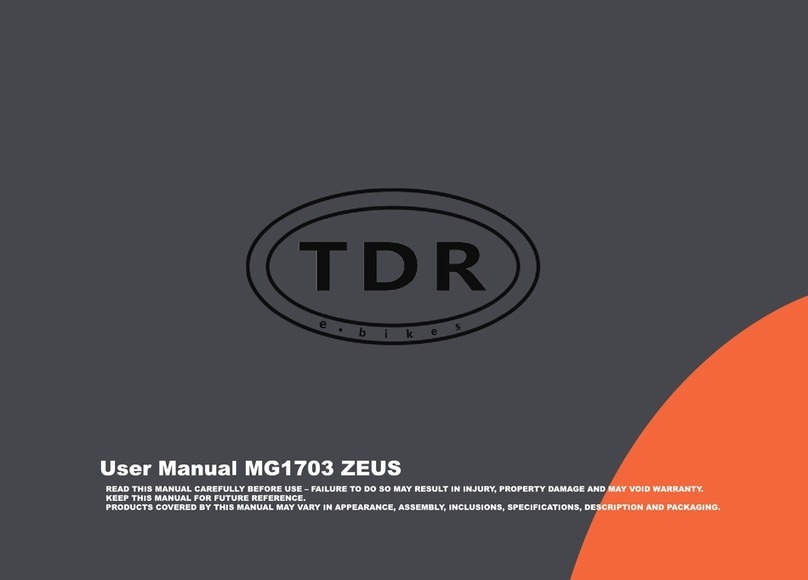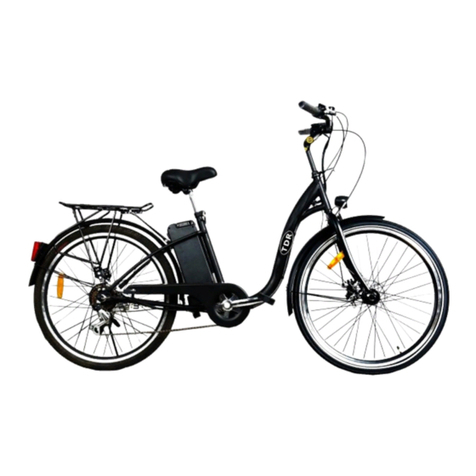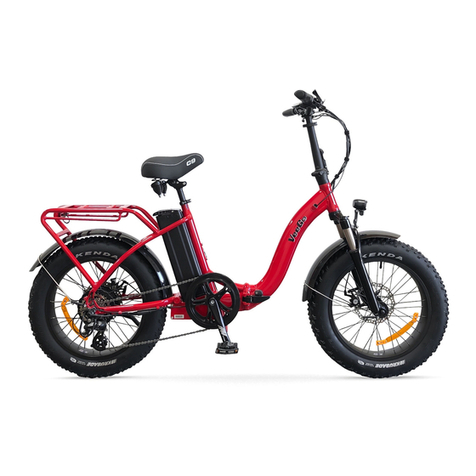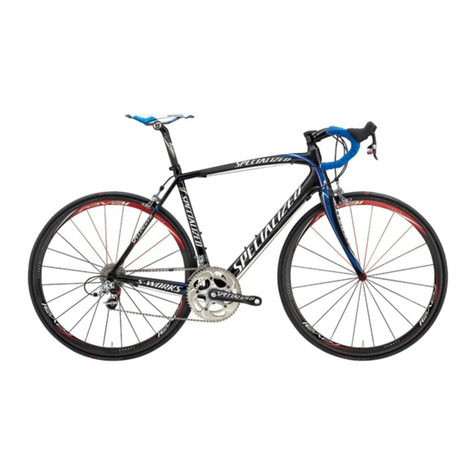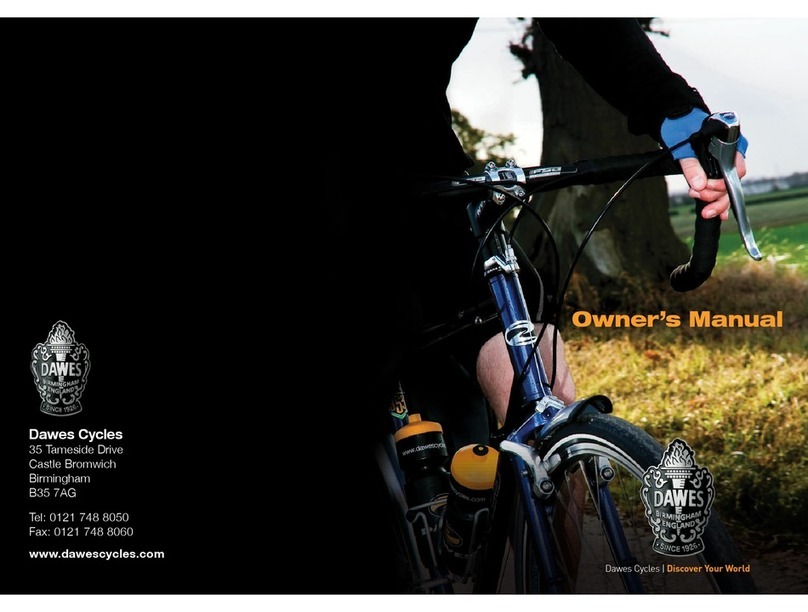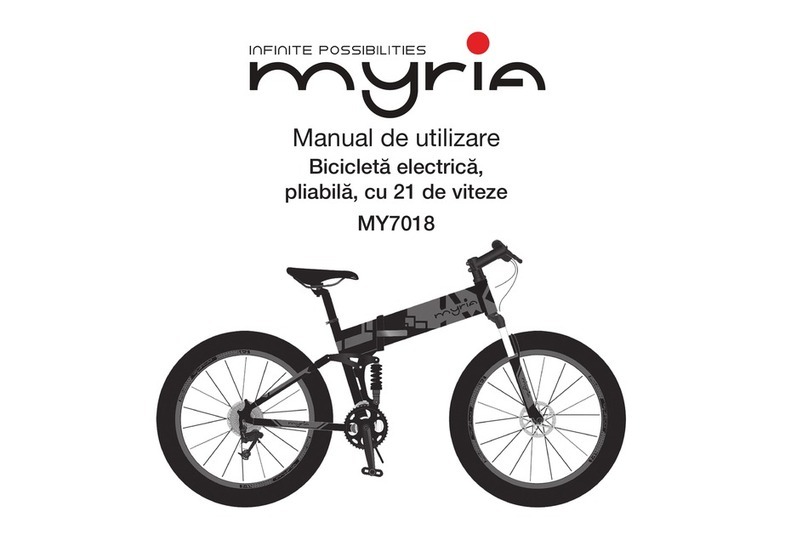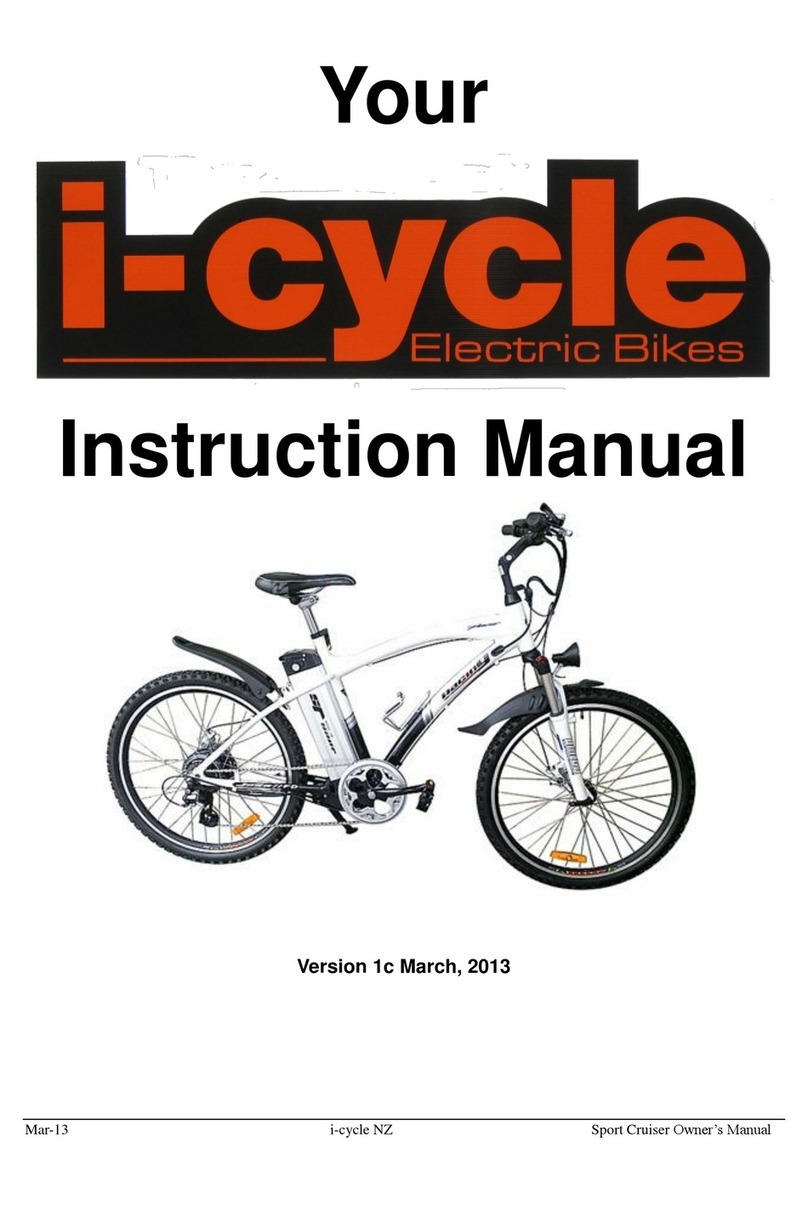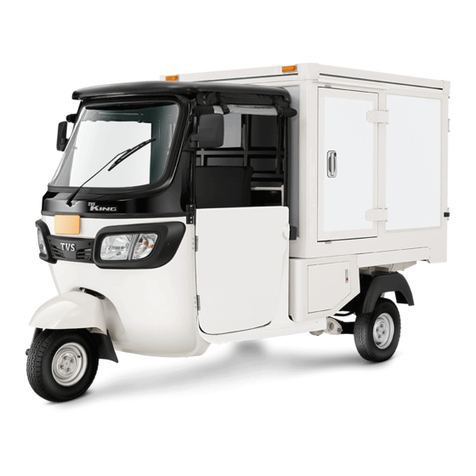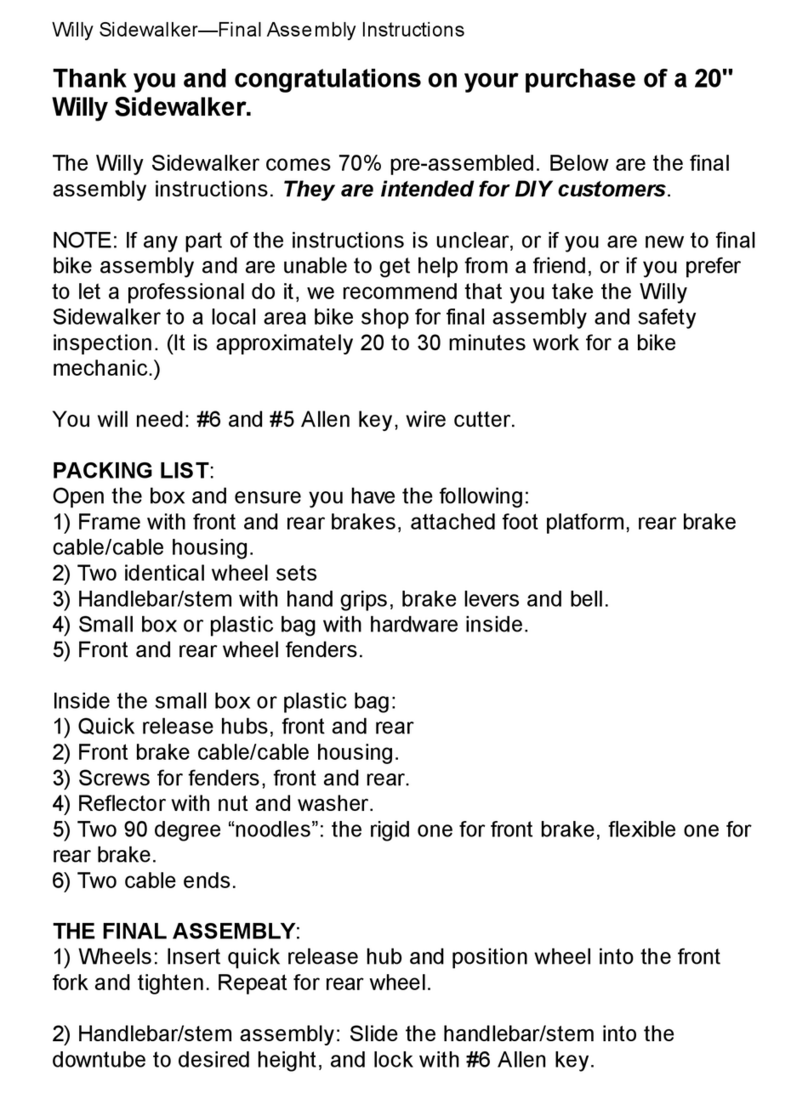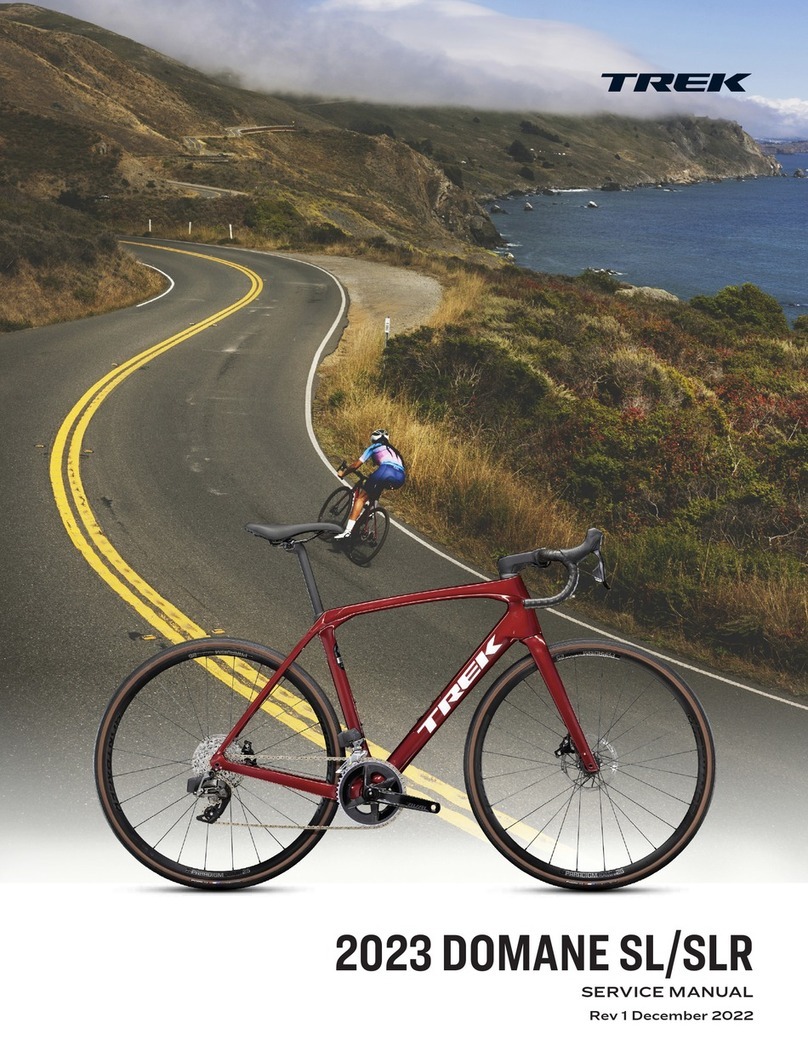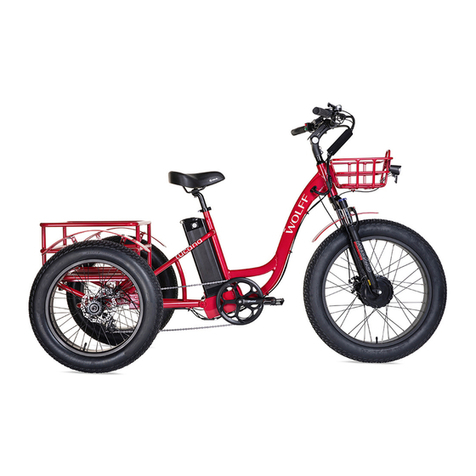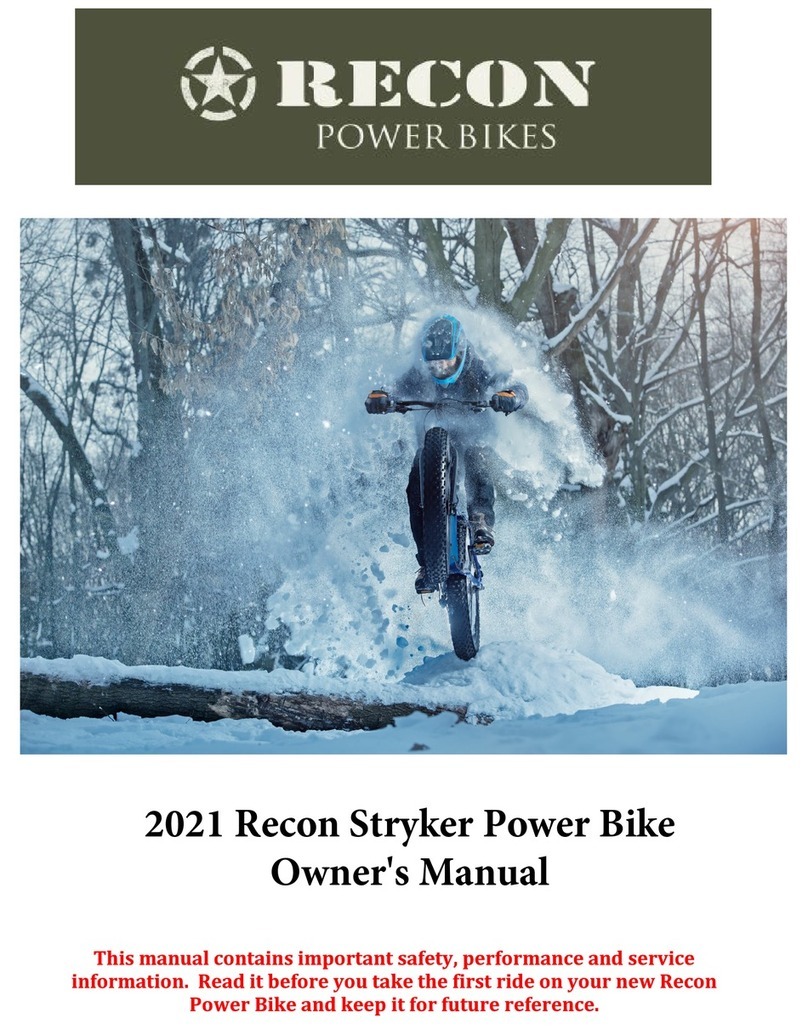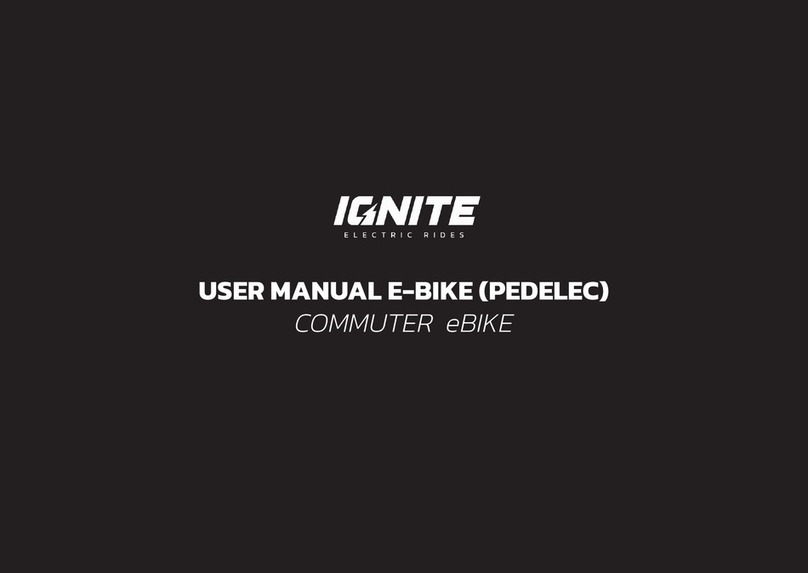TDR FLEXI S501 User manual

FLEXI S501 20” Electric Folding Bicycle
© 2020 TDRMOTO 1
TDR FLEXI S501 FOLDING
20” Electric Bike
User Manual
[Revision 1.0 MAR 2020]
READ THIS MANUAL CAREFULLY BEFORE USE –FAILURE TO DO SO MAY RESULT IN INJURY, PROPERTY DAMAGE AND MAY VOID
WARRANTY.
KEEP THIS MANUAL FOR FUTURE REFERENCE.
PRODUCTS COVERED BY THIS MANUAL MAY VARY IN APPEARANCE, ASSEMBLY, INCLUSIONS, SPECIFICATIONS, DESCRIPTION
AND PACKAGING.

FLEXI S501 20” Electric Folding Bicycle
© 2020 TDRMOTO 2
Safety
•Riding can be a hazardous activity. Certain conditions may cause the equipment to fail without
fault of the manufacturer. The product can and is intended to move, and it is therefore possible to
lose control, fall-off and/or get into dangerous situations that no amount of care, instruction or
expertise can eliminate. If such things occur, you can be seriously injured or die, even when using
safety equipment and other precautions. RIDE AT YOUR OWN RISK AND USE COMMON-SENSE.
FAILURE TO USE COMMON- SENSE AND HEED ALL SAFETY WARNINGS AND
RECOMMENDATIONS INCREASES RISK OF INJURY. USE THE PRODUCT ONLY WITH
APPROPRIATE CAUTION AND SERIOUS ATTENTION TO SAFE OPERATION.
•Before riding on the road, take time riding in an enclosed area to familiarise yourself with the
controls and behaviours of an electrically assisted bicycle. Try all settings so you are familiar with
the results.
•Before every ride, check bicycle condition and ensure that no fasteners are loose, particularly
axles, pedals, seat and handlebars. Ensure that the tyres are inflated to within specification
(printed on the tyre sidewall), and that the brakes are operating correctly.
•Maximum load capacity = 100kg.
•Understand and obey any local laws or regulations which may affect locations where the product
may be used. Ride defensively.
•Before each ride, check to ensure the frame latch, frame latch safety hook, handle post latch and
handle post safety hook are all properly secured. When secured, the frame and handle post will
be completely rigid.
•This product is manufactured for performance and durability but is not impervious to damage.
Stunts or other aggressive riding can over-stress and damage the product, and the rider assumes
all risks associated with how the product is looked after.
•Keep fingers and other body parts away from moving components.
•Always wear suitable protective equipment, such as an approved safety helmet (with chin strap
securely buckled). A helmet may be legally required by local law or regulation in your area. Wear
suitable footwear for bicycle riding and clothing that helps make you visible to others.
Battery and Charging
•Never modify the electrical system. Alterations could cause a fire resulting in serious injury and
could also damage the electrical system.
•Charge with the supplied or recommended charger only. Use of the wrong charger could cause a
fire or explosion resulting in serious injury.
•Ensure the voltage and frequency of the charger is compatible with mains electrical supply.
•Use the battery charger in dry locations only.
•Regularly check the charger for damage to the electrical cord, plug, enclosure and other parts. If
any damage or malfunction occurs, do NOT use the charger until repaired or replaced.
•Use caution when charging.
•Do not operate the charger or charge batteries near flammable materials.
•Do not clean or perform any maintenance on the product when it is being charged.

FLEXI S501 20” Electric Folding Bicycle
© 2020 TDRMOTO 3
Introduction
Congratulations on purchasing a TDR pedal assisted folding bicycle. We hope you enjoy years of
satisfactory and safe riding.
Read the manual
This manual is provided to help you to get the best performance, comfort, enjoyment and safety from
your bicycle. The manual describes specific care and maintenance procedures that help protect your
warranty and ensure trouble-free use. Please pay particular attention to the section on battery charging
and maintenance.
Read the manual before assembling and riding your bicycle.
Note that the manual is not intended to be an extensive reference source for servicing, maintenance
and/or repairs. For additional assistance, contact an authorised TDRMOTO service centre.
In the interests of your safety and the safety of others, it is highly recommended to have your bicycle
assembled and serviced / adjusted by a skilled bicycle mechanic.

FLEXI S501 20” Electric Folding Bicycle
© 2020 TDRMOTO 4
Product Layout
Note: the illustrations in this user manual may differ slightly from the bike model you received.
Folding and unfolding instructions are similar and should be used as a reference guide.
Tools Required for Assembly
The bicycle may come supplied
with some tools. But, you may
require some other tools which not
included for maintenance.
No.
Name
1
Handlepost
2
Handlepost Latch
3
Frame Latch
4
Seat
5
Pedal
6
Bike Stand
7
Battery

FLEXI S501 20” Electric Folding Bicycle
© 2020 TDRMOTO 5
Unfolding Instructions
Step One:
Carefully place the bicycle on a flat
surface.
Step Two:
Swing the front and rear halves
of the bike frame apart.
Step Three:
PULL the lever to release the
bottom pin.
Lock the frame latch lever by
pushing it towards the frame.
Step Four:
Move the frame latch safety hook
into the closed position.
Step Five:
Swing the post handle up to the
vertical position.
Step Five:
Push the handle post latch
inwards until it snaps closed.
Step Six:
Please make sure the spacer places
closed and safety locked.
Step Seven:
Simply flip the pedal into the
horizontal position.
Be careful to keep your fingers
outside the body of the pedal, or
they may be pinched by the
folding mechanism.
Step Nine:
You are now ready to ride!
Enjoy your ride and stay safe!

FLEXI S501 20” Electric Folding Bicycle
© 2020 TDRMOTO 6
Folding Instructions
Step One:
Prepare to fold your bicycle by
standing on the side with the
chain. The chain and crank
should be in front of you.
Step Two
Press the pedal and flip the
pedal upward.
Be careful to keep your fingers
outside the body of the pedal,
or they may be pinched by the
folding mechanism.
Step Three:
Unlock the handle post latch.
Step Four
Swing the handle, post into the
folded position, which is upside
down and flush against the front
wheel and frame.
Step Five:
Move the frame safety hook to
the open position.
PULL the lever to release the
bottom pin.
Step Six:
Fold the frame in half by
swinging the front half of the
frame back until the two wheels
are parallel.
Your bicycle is now ready for
easy transportation or storage.
Remove Battery from the Bike
Step 1:
Fold the seat by pressing the
lever at the back of seat .
Step 2:
Turn the key into “UNLOCK”
position.
Step 3:
Pull the handle of battery and
remove it from the bike.

FLEXI S501 20” Electric Folding Bicycle
© 2020 TDRMOTO 7
Handlebar Assembly
Carefully place the bicycle assembly on a flat surface so that it rests on the front fork and rear wheel.
Place and slide the handlebar assembly centrally into position in the clamp, rotate the handlebar
assembly, as required, so it is aligned "square" to the front fork. That is, the handlebar will be at 90°to the
bicycle frame when the front wheel is straight.
Using an Allen key and torque wrench, tighten the screws to the torque.
Handlebar Installation Video Guide is available at
https://ct110.com.au/user-manual/S501-Handlebar.mp4

FLEXI S501 20” Electric Folding Bicycle
© 2020 TDRMOTO 8
Presentation of LCD Screen

FLEXI S501 20” Electric Folding Bicycle
© 2020 TDRMOTO 9
Guidelines for Using Pedal Assistance
To get the best performance and service life from the pedal assistance system,
understand and apply the following techniques:
Note that some characteristics of how pedal assistance functions may differ from that
described here as a result of some special function settings.
•Pedal assistance progressively reduces as bicycle speed increases, and stops
completely when the current speed exceeds 25kmh. Pedal assistance re-engages
when speed drops below 25kmh (provided you are pedalling).
•Pedal assistance automatically reduces or disengages whenever the brakes are
activated (and / or when you stop pedalling).
Using Gears
Some model bicycles are equipped with gears. Gears are
used to change the ratio between rotations of the rear
wheel and the crank set. This enables you to pedal less and
travel faster on flat or downhill sections, or pedal faster and
travel slower to climb hills. Gearing is independent to pedal
assistance, so pedal assistance operates the same
regardless of selected gear. Remember, however, that pedal
assistance is "governed" by overall speed.
The selectable gears (A) are located on the rear wheel,
known as a "gear cluster" or "cassette". The larger the gear,
the less number of rotations per rotation of the crank. The
largest gear is the "lowest" and is referred to as "1". As each
gear becomes smaller, it is a "higher" gear then the previous
and is numbered sequentially. The number of gears may
vary between different models. Beneath the gear cluster is
the derailleur mechanism (B), which moves the chain so it
runs on different gears. The derailleur is operated by the
rider using controls mounted on the handlebars. The gear
change is "indexed" so each gear selection positively
engages –this is factory set and should require no
adjustment. There may be slight variations between bicycle
models in method to change gear "up" (from a lower gear to
a higher gear), or to change gear "down" (from a higher gear
to a lower gear). The image shows a "6-speed" type that
uses a button (C) for changing up gears (push button to
activate derailleur), and a lever (D) for changing down
gears (rotate lever forward to activate derailleur).

FLEXI S501 20” Electric Folding Bicycle
© 2020 TDRMOTO 10
Using Brakes
All bicycle models are equipped with a front and rear wheel braking system. Brakes are used to slow the
bicycle down. The braking systems may use different mechanics, however, the functionality is the same,
and that is to change the energy of the moving bicycle into heat energy ("friction"):
•For disc brakes, this means pads made from a special friction material pinching
against a disc mounted to the centre of the bicycle wheel.
•For rim type "caliper" or "noodle" brakes or “V -Brake”, this means rubber blocks
pinching the outer rim of the bicycle wheel (not the tyre).
•For drum brakes, this means pushing sections (known as "shoes") of special
friction material against the inside of cylinder fixed to the centre of the bicycle
wheel.
The brakes are operated by the rider through levers mounted to the handlebars. The left-hand lever
operates the rear brake, the right- hand lever operates the front brake. The ability of the rider to
adequately slow and/or stop the bicycle depends largely on the skill of the rider, the surface being ridden
on and other factors such as rain, tyres, adjustment and condition of the brake parts etc
Disc Brake Adjustment and Maintain
Typical Disc Brake
Typical Rim Brake (V-
Brake)
Typical Drum Brake

FLEXI S501 20” Electric Folding Bicycle
© 2020 TDRMOTO 11
Guidelines for Using Brakes
To get the best performance and service life from the brake system, understand and apply the following
techniques:
•In wet conditions, which reduces friction, always provide additional distance for braking and
adjust how quickly you apply the brakes.
•When applying the brakes, particularly the front brake, use a lower pressure to start with until
you feel the brakes starting to "bite", then increase pressure as required. Do NOT over-apply the
brakes and cause the wheel to stop rotating –this may result in loss of control.
•Maintain the brake friction components (pads, shoes, rubbers) in good condition and replace
when they reach the wear limit.
•Maintain brake adjustment so that the brakes perform effectively, the levers are comfortably
positioned, and there is not excessive play in adjustable components.
•If the brakes are not performing effectively, making abnormal noise or any part is not serviceable
or cannot be adjusted correctly, have the brakes inspected and adjusted by a bicycle mechanic or
suitably qualified person.
•If the brake cables become frayed or otherwise damaged, have them replaced by a bicycle
mechanic or suitable qualified person.

FLEXI S501 20” Electric Folding Bicycle
© 2020 TDRMOTO 12
Batteries and Battery Charging
Never modify the electrical system. Alterations may cause a fire, resulting in serious injury and could also
damage the electrical system. • Charge with the supplied charger only. Use of the wrong charger may
cause a fire or explosion, resulting in serious injury. • Ensure the voltage and frequency of the charger is
compatible with mains electrical supply. • Use the battery charger in dry locations only. • The battery
must be charged before first use. • For maximum battery performance and service life, charge the battery
after each use, and charge at temperatures between 0 and 40°C (32 and 104°F). • Battery charging
generally takes up to 4 - 8 hours from discharged to fully charged. Do NOT charge the battery
continuously for more than 24 hours. • If the bicycle has not been used for over 4 weeks, charge the
battery before use. • Always switch the bicycle OFF after each use.
The battery pack can be recharged repeatedly. However, rechargeable batteries eventually need to be
replaced. A significantly reduced operating period after charging indicates that the battery is no longer
serviceable and should be replaced. Discard old batteries in an environmentally responsible manner.
The battery charger has a charge status LED indicator:
•Red - Battery charging.
•Green - Battery fully charged or disconnected.
To charge the battery:
Remove the battery from the bicycle, then plug the charger connector into the charging port.
Connect the charger to a mains electrical supply and switch ON. The indicator LED on the charger
illuminates red to show the battery is charging.
When the battery is charged (approximately 6-8 hours), the charger indicator LED illuminates green.
Disconnect the charger from the electrical supply, then put the battery back to the bicycle.
Battery Storage
When storing the batteries for a long period of time:
Charge the batteries at least every 30 days to avoid capacity loss. Batteries slowly self-discharge when
unused over a long period. If the battery cells are left at a critically low charge state, the lifespan and
capacity will be permanently reduced.
Always disconnect the charger from the mains electrical supply and battery before storing the battery.
Avoid storing batteries in extreme temperatures, whether hot or cold. The recommended battery storage
temperature is between 0 and 25°C (32 to 77°F). Avoid exposing batteries to temperatures at or above
40°C (104°F) for extended periods.
Batteries are best kept in a cool, dry place. Do not allow batteries to accumulate condensation, as this may
cause shorting or corrosion.
Tyre Pressures
The tyres must always be inflated to the correct pressure (as specified on the tyre sidewall) before every
ride. Riding the bicycle with either too low or too high pressures will affect bicycle performance, may
affect effective electrical assistance range, and may render the bicycle as dangerous. Use an accurate
pressure gauge when checking pressures.
Maintenance
Some maintenance activities described may be beyond the scope of some users. Do NOT attempt
procedures that you are not comfortable with, or do not have the necessary tools, experience or
knowledge for –take the unit to an authorised service centre or qualified technician for servicing. Items
in the maintenance schedule below that are recommended to be performed by a qualified technician are
highlighted yellow. Failure to follow the maintenance recommendations, using incorrect or non-
compatible accessories or replacement parts, or general negligence may result in making the product

FLEXI S501 20” Electric Folding Bicycle
© 2020 TDRMOTO 13
warranty void. Improper adjustment or service may result in damage to the bicycle or make it hazardous.
Maintenance requirements may be affected by any number of factors from your riding style to geographic
location. When new, parts of the bicycle may "break-in" over the course of the first approximate 100km of
riding, possibly including the stretching of cables, spoke tension changes etc. It is recommended to have
the bicycle inspected and serviced at an authorised service centre or by a qualified technician.
The bicycle components are subject to wear and stress. If a component is weakened through stress, age
etc, it may fail without warning. It is important to regularly inspect the bicycle for any signs of component
fatigue –look for cracks, fraying, discoloration etc, as this may indicate that a part is near the end of its
useful life and should be replaced.
•Clean the bicycle with a soft, damp cloth –do NOT use high-pressure water cleaners or hoses,
pressurised air, solvents, abrasives etc. For the console, battery and motor, do NOT use any
liquids.
•When transporting in a vehicle, it is recommended to have the battery out of the bicycle during
transport.
•Store the bicycle where it will be protected from rain, sun etc to help prevent corrosion, fading
etc.
•For safety, longest possible service life and reliability, maintain the bicycle properly. Use the
maintenance schedule below for guidance. It is very important that you check certain systems
and components before each and every ride. The proper condition and function of these systems
is critical to your safety.
*Every 5 to 10 rides depending on ride length and conditions.

FLEXI S501 20” Electric Folding Bicycle
© 2020 TDRMOTO 14
Maintenance
Schedule
Component / Condition
Check Before
Every Ride
*Check
Periodically
Clean /
Lubricate
Adjust /
Tighten /
Replace as
Required
Tyre Pressure
■
■
Tyre Wear / Damage
■
■
Brake Adjustment
■
■
Handlebar Tightness
■
■
■
Controls and Displays
■
Seat Post Tightness
■
■
Fasteners / Mounting
Hardware
■
Brake Pads
■
■
Brake Cable Wear
■
■
Chain
■
■
■
Reflectors
■
Battery / Charger
■
■
Steering Head Bearings
■
■
■
Derailleur
■
■
■
Wheel Spoke Tension
■
■
Wheel Trueness
■
■
Wheel Bearings
■
■
■
Bottom Bracket (Crank)
Bearings
■
■
■

FLEXI S501 20” Electric Folding Bicycle
© 2020 TDRMOTO 15
Troubleshooting
Malfunction
Possible Cause
Possible Solution
Pedal assistance not
working
1.
Under-charged battery.
2.
Battery no longer serviceable.
3.
Battery charger faulty.
4.
Motor electrics or switches damaged
/ faulty.
1.
Charge battery. Follow battery care procedures.
2.
Have battery checked. Replace if faulty.
3.
Have charger checked. Replace if faulty.
4.
Seek diagnosis and repair from authorised
service centre.
Reduced range and/or
speed
1.
Under-charged battery.
2.
Battery no longer serviceable.
3.
Low tyre pressure.
4.
Brakes dragging.
5.
Terrain, headwind, etc.
1.
Charge battery. Follow battery care procedures.
2.
Have battery checked. Replace if faulty.
3.
Inflate to recommended pressure.
4.
Adjust.
5.
Normal.
Gear change (where
applicable) rough /
not changing
1.
Derailleur cables sticking /
stretched / damaged.
2.
Derailleurs / shifter not correctly set.
1.
Lubricate / adjust / replace cables.
2.
Adjust.
Chain slip / jumping
off sprockets
1.
Worn sprockets.
2.
Stretched chain.
3.
Front sprocket loose / out of true.
4.
Sprocket teeth bent / broken.
5.
Derailleur / shifter not
correctly adjusted.
1.
Replace.
2.
Replace.
3.
Re-true / tighten.
4.
Replace.
5.
Adjust.
Clicking noises when
pedaling
1.
Stiff chain link.
2.
Loose pedals / bearings.
3.
Loose bottom bracket / bearings.
4.
Bent bottom bracket or pedal bolt.
5.
Loose pedal arm bolts.
1.
Lubricate chain.
2.
Tighten / adjust bearings.
3.
Tighten / adjust bearings.
4.
Replace.
5.
Tighten.
Grinding noise when
pedaling
1.
Pedal bearings too tight.
2.
Bottom bracket bearings too tight.
3.
Rear wheel not straight.
4.
Chain too tight.
5.
Derailleur dirty.
1.
Adjust.
2.
Adjust.
3.
Align so chain straight.
4.
Adjust.
5.
Clean and lubricate.
Brakes not effective
1.
Pads worn.
2.
Pads / discs dirty.
3.
Brake cables binding /
stretched / damaged.
4.
Brakes levers binding.
5.
Brakes require adjustment.
1.
Replace.
2.
Clean and degrease.
3.
Lubricate / adjust / replace cables.
4.
Clean pivots.
5.
Adjust.
Brakes squeal
1.
Pads / discs dirty.
2.
Brakes not centred.
3.
Caliper fasteners loose.
1.
Clean and degrease.
2.
Centre brakes and adjust.
3.
Tighten.
Brakes chatter / vibrate
1.
Brake mounting bolts loose.
2.
Brakes out of adjustment.
3.
Steering head bearings loose.
1.
Tighten.
2.
Centre brakes and adjust.
3.
Adjust bearings.
Wheel vibration / wobble
1.
Axle bent or broken.
2.
Wheel out of true.
3.
Wheel hub bearings loose /
not serviceable.
4.
Quick-release (if equipped)
mechanism loose.
1.
Replace.
2.
True wheel.
3.
Adjust / replace.
4.
Adjust.
Steering not accurate
1.
Wheels not aligned to frame.
2.
Steering head loose / binding.
1.
Align wheels.
2.
Adjust.

FLEXI S501 20” Electric Folding Bicycle
© 2020 TDRMOTO 16
3. Front forks or frame bent.
3. Straighten.
Motor "clicks" / has
reduced power and/or
shuts off
1.
Under-charged battery.
2.
Motor internal fault.
1.
Charge battery. Follow battery care procedures.
2.
Replace.
No power when pedal
assistance switched ON
1.
Blown fuse.
2.
Loose connectors / wiring damage.
3.
Faulty switch.
4.
Faulty controller.
1.
Replace.
2.
Check connectors / wiring. Replace as required.
3.
Replace.
4.
Replace.
Pedal assistance OK, but
no display
1.
Loose connectors / wiring damage.
2.
Faulty controller.
1.
Check connectors / wiring. Replace as required.
2.
Replace.
Display OK, but no pedal
assistance
1.
Loose motor connectors /
wiring damage.
2.
Poor contact at battery terminals.
3.
Faulty braking sensor.
1.
Check connectors / wiring. Replace as required.
2.
Inspect and clean terminals.
3.
Replace.
Bicycle runs at full speed
without pedalling
1.
Faulty crank sensor.
2.
Faulty controller.
1.
Replace.
2.
Replace.
3.
Replace.
Pedal assistance operating
intermittently or not as
expected
1.
Loose connectors / wiring damage.
2.
Faulty controller.
3.
Faulty crank sensor.
1.
Check connectors / wiring. Replace as required.
2.
Replace.
Charger shows "full
charge" in an unusually
short amount of time
1.
Faulty charger.
2.
Faulty batteries.
1.
Replace.
2.
Replace.
Charger indicator not
illuminating when
charger is plugged into
outlet
1.
Outlet has no power.
2.
Faulty charger.
1.
Check charger plugged in and electrical supply ON.
2.
Replace.
Charger indicator flashes
red and never changes to
green
1.
Damaged wire from charger to battery.
2.
Faulty batteries.
1.
Replace charger.
2.
Replace.

FLEXI S501 20” Electric Folding Bicycle
© 2020 TDRMOTO 17
If you have any questions regarding any issues with your electric bicycle, please contact our Customer
© 2020 TDRMOTO. All rights reserved. No part of this document, including
descriptive content, concepts, ideas, diagrams or images may be reproduced or
transmitted in any form or by any means, electronic or mechanical, including
photocopying, scanning or recording, or any information storage and retrieval
system, without express permission or consent from the publisher.
Some experts believe that the incorrect or prolonged use of almost any product may cause
serious injury or death. To help reduce your risk of serious injury or death, refer to the
information below.
◼Consult all documentation, packaging and
product labelling before use. Note that some
products feature documentation available
online. It is recommended to print and retain
the documentation.
◼Before each use, check the product for
loose/broken/damaged/missing parts, wear
or leaks (if applicable). Never use a product
with loose/broken/damaged/missing parts,
wear or leaks.
◼Products must be inspected and serviced (if
applicable) by a qualified technician every 6
months. This is based on average residential use
by persons of average size and strength, and on
a property of average metropolitan size. Use
beyond these recommendations may require
more frequent inspections/servicing.
◼Ensure that all users of the product have
completed a suitable industry recognized
training course before being allowed access to
the product.
◼The product has been supplied by a general merchandise retailer
that may not be familiar with your specific application or
description of application. Be sure to attain third-party approval
from aqualified specialist for your application before use,
regardless of any assurances from the retailer or its
representatives.
◼This product is not intended for use where fail-safe operation is
required. As with any product (for example, automobile,
computer, toaster), there is the possibility of technical issues that
may require the repair or replacement of parts, or the product
itself. If the possibility of such failure and the associated time it
may take to rectify could in any way inconvenience the user,
business or employee, or financially affect the user, business or
employee, then the product is not suitable for your requirements.
This product is not intended for use where incorrect operation or
a failure of any kind, including but not limited to, a condition
requiring product return, replacement, parts replacement or
service by a technician may cause financial loss, loss of employee
time or an inconvenience requiring compensation.
◼If this product has been purchased in error when considering the
information presented here, contact the retailer directly for
detailsof their returns policy, if required.

12 Month Limited Warranty
We warrant against possible manufacturing defects providing the following conditions are satisfied:
•Product is completely and correctly assembled
•Product is used under normal condition for its intended purpose
•Product receives all necessary maintenance and adjustments
•Product is used for general transportation or recreational use only
What is covered by this Limited Warranty;
1 Year Frame only
1 Year Warranty on Motor only
1 Year Warranty on Battery only
What is not covered by this Limited Warranty:
•When the bicycle is used negligently or results in damage due to traffic accident.
•Top Speed is not covered under warranty, if your electric bike does not reach estimated top speeds, this is
not covered under warranty.
•If your electric bike does not reach the factory estimated distance advertised, and can vary depending on how
you use the electric bike and the total weight carried, this is not covered under warranty.
•All batteries will and do lose capacity over time, capacity loss is not covered under warranty. (If the battery
unit is used incorrectly or seal tampered with, this will void your battery warranty). Others that is not covered
under warranty for battery are; If you have not charged your battery regularly, left your battery sitting
unused for over more than 3 months, If you damaged your charger or battery by incorrect use.
•When your battery starts to lose capacity, and runs for less distance, this is not covered under warranty.
•Damage due to normal wear and tear and maintenance. Parts that are not covered under warranty under
normal wear and tear include; tires, tubes, brakes, brake pads, derailleur and gear adjustments, tightening on
all nuts, spokes, bottom bracket, chain and general adjustments (Please have your bike service regularly by a
bicycle mechanic)
•Rust and corrosion on bike is not covered under warranty.
•Damage due to external causes will not be covered under warranty.
•Any minor scratches, marks or imperfections will not be covered.
Warranty will be void if the product is ever:
•Used in any competitive sport
•Modified in any way, includes but not limited to: modifications to the bicycle, components , electrical
components
•Misused, abused or neglected
•Rented, for commercial use, sold or given away
TDRMOTO will not be liable for incidental or consequential loss or damage due directly or indirectly from use of this
product.
Warranty and Repair Claim
To claim your warranty, please provide proof of purchase and contact us via email or phone listed below.
The cost of sending and returning of your TDR electric bike is at the customers expense.
Warranty repair timeframe may take up to 60 days depend on replacement part availability. If there is a delay due to the nature of the
repair, or a delay beyond our control, we will inform you and do whatever possible to limit the turnaround time of your product.
Other Repairs
All TDR electric bike repairs which is not covered by warranty can also be repaired at authorised service centre at the customers
cost.We will carry most of the spare parts on our current and past models. Should you wish to purchase any parts, please contact us.
Contact Information
Website: www.tdrmoto.com.au Email: [email protected]
Address: 14 Hammer Court Hoppers Crossing VIC 3029 Phone Number: 03 9931 1626
Our goods and services come with guarantees that cannot be excluded under the Australian Consumer Law. For major failures with
the service, you are entitled:
•to cancel your service contract with us; and
•to a refund for the unused portion, or to compensation for its reduced value.
You are also entitled to choose a refund or replacement for major failures with goods. If a failure with the goods or a service does not
amount to a major failure, you are entitled to have the failure rectified in a reasonable time. If this is not done you are entitled to a
refund for the goods and to cancel the contract for the service and obtain a refund of any unused portion. You are also entitled to be
compensated for any other reasonably foreseeable loss or damage from a failure in the goods or service.
Table of contents
Other TDR Bicycle manuals
